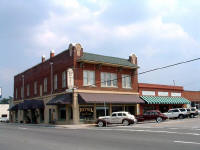|
The
town was founded by the officers of the Pensacola & Atlantic Railroad, a
subsidiary of the Louisville & Nashville Railroad. The P&A Railway was
organized to connect the terminus of the L&N near Pensacola to the western
terminus of the Seaboard Railroad at River Junction -- now Chattahoochee
-- in the 1880s. It was named after Frederick R. DeFuniak, the president
of the L&N. Like much of Northwest Florida, DeFuniak Springs was settled
mainly by Scots from Virginia and the Carolinas.
DeFuniak Springs was established as a final-destination resort, and the
developers enlisted the cooperation and aid of the Chautauqua Movement.
The Chautauqua Hall of
Brotherhood, an auditorium seating 4,000, was constructed on Lake
DeFuniak in the center of town. Seminars, classes, and the like were held
in the Hall of Brotherhood building for people on vacation. The auditorium
of the building was severely damaged by Hurricane Eloise in 1975 and
razed, although a charitable foundation, The Chautauqua Hall of
Brotherhood Foundation, Inc., has undertaken a capital campaign for the
historic restoration of the building. The Westerly portion of the building
facing Circle Drive is still in use.
As part of the intellectual atmosphere of the town, a college and a
private high school (named Palmer College and Palmer Academy,
respectively), as well as a technical school (Thomas Industrial Institute)
and a teacher training school (Florida Normal College) were established in
the 19th century. Florida Normal College was incorporated into Florida
State University, while the other schools closed during the Great
Depression. There remains a College Avenue that once led to Palmer
College.
As demonstrated through the Chautauqua movement, many residents of
DeFuniak Springs have always had an active hand in education. In 1886, De
Funiak Springs held an important meeting that forever changed the course
of public education in Florida. At this meeting, teachers around the state
formed the Florida Education Association (FEA). This teacher's union
remains the state's predominant voice for educators and is affiliated with
the National Education Association (NEA) and the American Federation of
Teachers (AFT).
The town also contains various other historically significant landmarks.
Near the Chautauqua Hall of Brotherhood building is the Walton County
Library on Circle Drive, the oldest existing, operatin library in the
state of Florida. The library contains an interesting assortment of
antiquities, including an impressive medieval weapon collection and many
first-edition books. First Presbyterian Church is the only private
structure in the Lake Yard, the park surrounding the lake. Also situated
on Circle Drive is St. Agatha's Episcopal Church, built in 1895-1896.
Although Walton County was opposed to secession, the first monument to the
Confederate war dead constructed in Florida is located on the lawn of the
Walton County Court House.
Sidney Johnston Catts, 22nd governor of Florida from
1917 to 1921, first candidate to campaign the state by automobile,
Prohibition Party affiliation. Catts was a lawyer and preacher, having
served as the pastor of First Baptist Church prior to his run for
governor.
Former professional baseball player and manager Buck Showalter was born in
DeFuniak Springs on May 23, 1956.
American fashion model Amanda Moore graduated from Walton High School in
DeFuniak Springs in 1997
PGA golfer Sammy Rachels, native of DeFuniak Springs, was born in 1950.
Ina Thompson was appointed Commissioner of the Florida Motor Vehicle
Commission by Leroy Collins, the 33rd Governor of Florida. At the time of
her appointment she was the first woman ever named to an office of that
rank in Florida Government.
| |
|
|
Downtown DeFuniak Springs is graced with many
attractive historic landmarks, gardens, and parks.
|
The Chautauqua Hall of Brotherhood is the
centerpiece of Circle Drive.
|
This home, built in the 1980's, is in keeping
with the older historic homes surrounding Lake DeFuniak.
|

The Hotel Defuniak, a Designated historic structure built in 1920,
located in downtown DeFuniak Springs. |
Demographics
As of the census of 2000, there were 5,089 people, 2,105 households, and
1,324 families residing in the city. The population density was 464.0
people per square mile (179.1/km²). There were 2,464 housing units at an
average density of 224.7/sq mi (86.7/km²). The racial makeup of the city
was 71.78% White, 22.99% African American, 1.00% Native American, 0.51%
Asian, 0.08% Pacific Islander, 1.81% from other races, and 1.83% from two
or more races. Hispanic or Latino of any race were 3.30% of the
population.
There were 2,105 households, out of which 27.4% had children under the age
of 18 living with them, 40.7% were married couples living together, 18.4%
had a female householder with no husband present, and 37.1% were
non-families. 33.5% of all households were made up of individuals and
16.2% had someone living alone who was 65 years of age or older. The
average household size was 2.30 and the average family size was 2.91.
In the city the population was spread out with 23.6% under the age of 18,
8.6% from 18 to 24, 24.4% from 25 to 44, 22.2% from 45 to 64, and 21.2%
who were 65 years of age or older. The median age was 40 years. For every
100 females there were 84.9 males. For every 100 females age 18 and over,
there were 78.7 males.
The median income for a household in the city was $24,516, and the median
income for a family was $28,750. Males had a median income of $24,219
versus $19,255 for females. The per capita income for the city was
$13,298. About 18.2% of families and 18.4% of the population were below
the poverty line, including 27.6% of those under age 18 and 9.3% of those
age 65 or over.
For More Information
regarding accommodations or Dining call: 850-951-2233
Defuniak
Springs Florida | History |
Parks & Recreation |
Library |
Chautauqua hall of
Brotherhood | Train Depot Station
| Hotels |
Restaurants
Copyright ©2014 DefuniakSpringsFlorida.net
|
|
|


